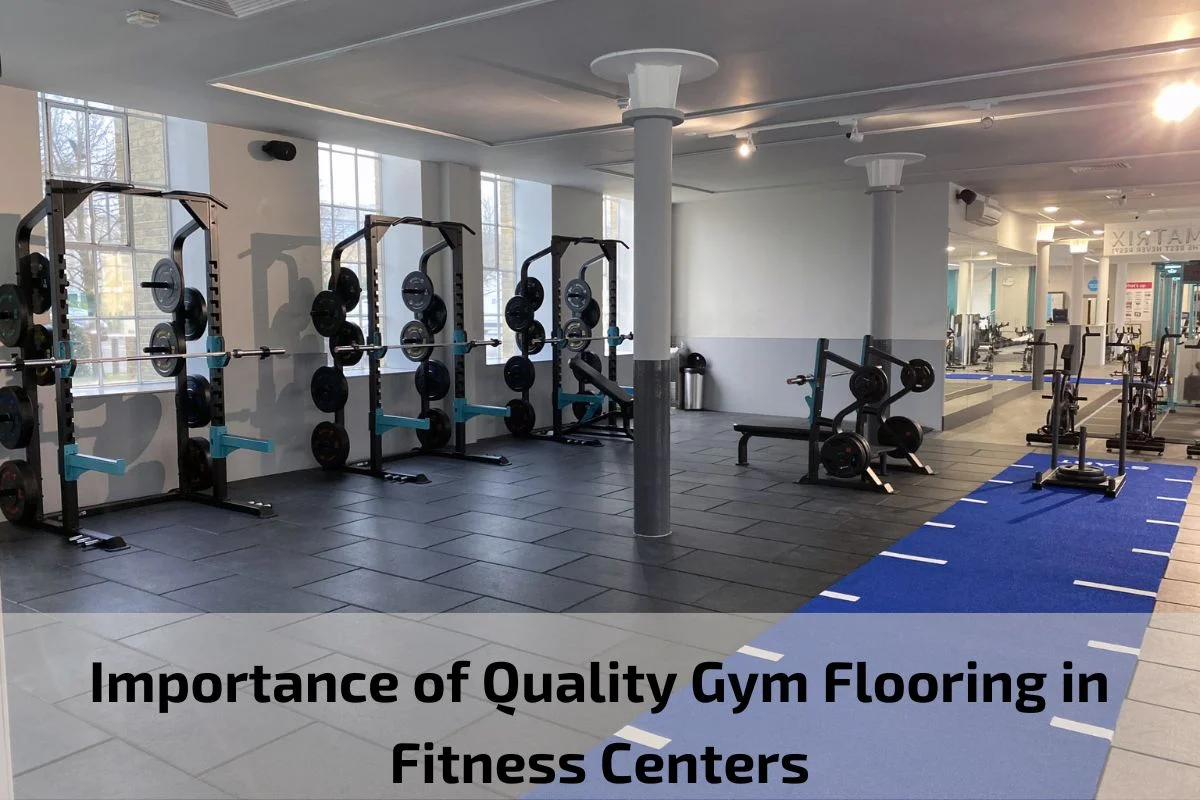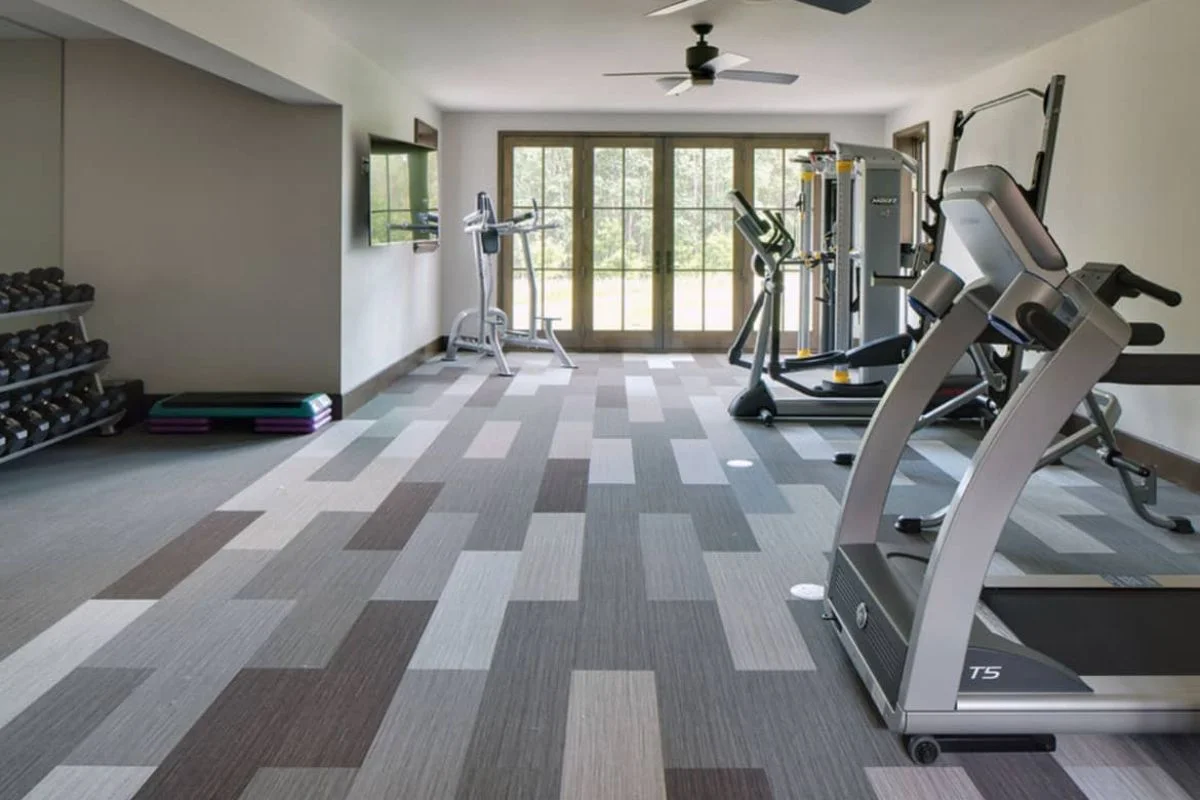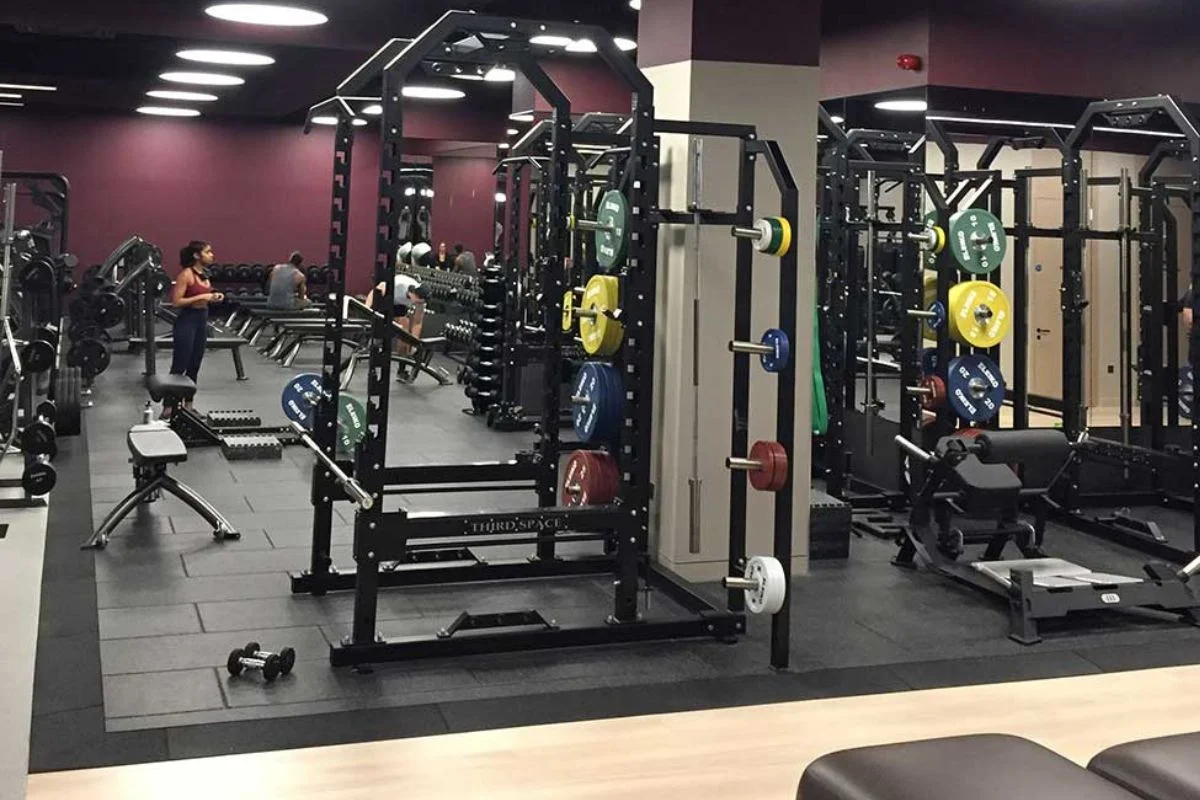Importance of Quality Gym Flooring in Fitness Centers
Quality gym flooring is a fundamental aspect of any fitness center, serving as the foundation for a safe, functional, and inviting exercise environment. From supporting heavy equipment to providing traction during intense workouts, gym flooring plays a crucial role in ensuring the comfort, safety, and overall experience of gym-goers.
In today’s fitness landscape, where diversity in workouts and training methods is celebrated, the importance of quality gym flooring cannot be overstated. Whether it’s weightlifting, cardio exercises, yoga, or group fitness classes, the right flooring surface can enhance performance, prevent injuries, and contribute to the success of a fitness facility.
In this guide, we will delve into the significance of quality gym flooring in fitness centers, exploring its impact on performance, safety, durability, and aesthetics. We’ll examine the key factors that gym owners and managers should consider when selecting and installing gym flooring, as well as the benefits it brings to both members and staff.
Importance of Gym Flooring in Fitness Centers
Gym flooring serves as the cornerstone of any fitness center, playing a pivotal role in ensuring the safety, functionality, and overall experience of gym enthusiasts. Here’s why quality gym flooring is of paramount importance:
- Safety: Gym flooring provides a stable and supportive surface for various exercises and activities, reducing the risk of slips, trips, and falls. Its shock-absorbing properties help minimize impact on joints and muscles, fostering a safer workout environment for individuals of all fitness levels.
- Durability: Fitness centers endure heavy foot traffic, equipment usage, and impact from weights and machines. High-quality gym flooring is engineered to withstand these rigorous conditions, offering exceptional durability and longevity without compromising on performance.
- Protecting Equipment and Subfloors: Gym flooring acts as a protective barrier for both the equipment and underlying subfloors. It helps absorb vibrations and impact, preventing damage to expensive gym equipment and minimizing noise transmission to adjacent spaces.
- Enhancing Performance: The right gym flooring enhances athletic performance by providing a stable and supportive surface for dynamic movements, weightlifting, and cardio exercises. It offers optimal traction and grip, allowing individuals to push their limits and achieve their fitness goals safely and effectively.
- Hygiene and Maintenance: Quality gym flooring is easy to clean and maintain, contributing to a hygienic and welcoming workout environment. Its non-porous surface resists moisture and bacteria buildup, reducing the risk of odors, mold, and mildew, and ensuring a clean and sanitary space for gym-goers.
- Aesthetics and Branding: Gym flooring plays a crucial role in shaping the aesthetic appeal and branding of fitness centers. With a wide range of colors, patterns, and textures available, gym owners can customize their flooring to reflect their brand identity and create an inviting and inspiring atmosphere for members.
The Role of Gym Flooring in Fitness Centers
Gym flooring plays a multifaceted role in the operation and functionality of fitness centers, encompassing various aspects that contribute to the overall experience of gym-goers. Here are key elements outlining the significance of gym flooring:
- Safety and Injury Prevention: Gym flooring serves as a protective layer that cushions impact and minimizes the risk of injuries during workouts. Its shock-absorbing properties help reduce strain on joints and muscles, providing a safer environment for individuals engaging in high-impact activities and heavy lifting exercises.
- Supporting Equipment and Activities: Gym flooring provides a stable foundation for fitness equipment, including treadmills, weight benches, and cardio machines. It also supports a diverse range of exercises, from bodyweight movements to free weight exercises, ensuring a versatile surface that accommodates various workout routines.
- Noise Reduction and Impact Absorption: High-quality gym flooring helps dampen noise and vibrations generated by equipment and foot traffic, creating a quieter and more comfortable workout environment. Its ability to absorb impact minimizes noise transmission to adjacent areas, allowing for a more enjoyable and distraction-free workout experience.
- Hygiene and Maintenance: Gym flooring with easy-to-clean surfaces promotes hygiene and sanitation within fitness centers. Its non-porous materials resist moisture, bacteria, and odor buildup, facilitating quick and efficient cleaning routines that uphold cleanliness standards and ensure a fresh and inviting atmosphere for gym members.
- Aesthetic Appeal and Branding: The appearance of gym flooring contributes to the overall aesthetic appeal and branding of fitness centers. With a variety of colors, textures, and patterns available, gym owners can customize their flooring to reflect their brand identity and create an inspiring and motivational space that resonates with members.
- Performance Enhancement: Optimal gym flooring enhances athletic performance by providing adequate traction, stability, and support during workouts. Its slip-resistant surface reduces the risk of accidents, allowing individuals to focus on their fitness goals and achieve maximum results with confidence and safety.
Types of Gym Flooring Materials
When it comes to gym flooring, various materials offer different characteristics and benefits suited to the needs of fitness centers. Understanding the types of gym flooring materials available can help gym owners make informed decisions when selecting the most suitable option for their facility. Here are some common types of gym flooring materials:
- Rubber Flooring: Rubber flooring is one of the most popular choices for gym facilities due to its durability, shock absorption, and slip resistance. It provides excellent traction and support for high-impact exercises and heavy equipment. Rubber flooring comes in various forms, including rubber tiles, rolls, and interlocking mats, offering versatility in design and installation options.
- Vinyl Flooring: Vinyl flooring is a cost-effective and low-maintenance option for gym facilities. It is highly resistant to moisture, stains, and scratches, making it ideal for high-traffic areas and fitness environments prone to spills and accidents. Vinyl flooring is available in rolls or tiles and offers a wide range of colors and patterns to suit different design preferences.
- Foam Flooring: Foam flooring is lightweight, soft, and shock-absorbing, making it ideal for areas where impact protection is crucial, such as yoga studios, stretching areas, and children’s play zones within gyms. Foam flooring is comfortable to stand and exercise on, providing cushioning and support for joints and muscles during workouts.
- Carpet Tiles: Carpet tiles offer warmth, comfort, and sound insulation benefits in gym environments. They provide a softer surface compared to rubber or vinyl flooring, making them suitable for areas where impact reduction and noise absorption are priorities. Carpet tiles are available in a variety of colors, textures, and pile heights, allowing for creative design possibilities.
- Wood Flooring: Wood flooring adds a touch of warmth and natural beauty to gym spaces. While not as common as rubber or vinyl flooring in fitness centers, wood flooring offers a classic and elegant aesthetic that complements a variety of interior styles. It provides a stable and resilient surface for aerobic exercises and functional training areas.
Considerations for Choosing the Right Gym Flooring
Selecting the appropriate gym flooring is a crucial decision for fitness center owners and managers. Several key considerations should be taken into account to ensure that the chosen flooring meets the needs of the facility and its members. Here are essential factors to consider when choosing the right gym flooring:
- Durability and Longevity: Gym flooring should be durable enough to withstand heavy foot traffic, equipment usage, and repeated impact from weights and exercise activities. Choosing high-quality materials that are resistant to wear, tear, and deformation ensures longevity and minimizes the need for frequent replacement.
- Shock Absorption and Impact Resistance: Opt for gym flooring with sufficient shock absorption and impact resistance properties to protect the subfloor and reduce the risk of injuries during workouts. Shock-absorbing materials help cushion landings and minimize stress on joints and muscles, promoting a safer and more comfortable exercise experience.
- Maintenance and Cleaning Requirements: Consider the maintenance and cleaning demands of different types of gym flooring materials. Choose flooring options that are easy to clean, resistant to stains, and require minimal upkeep to maintain hygiene and sanitation standards within the facility. Low-maintenance flooring solutions save time and resources in the long run.
- Aesthetics and Design Preferences: The appearance of gym flooring contributes to the overall ambiance and branding of the fitness center. Select flooring materials, colors, and patterns that align with the facility’s design aesthetic and brand identity. Consider factors such as color coordination, texture, and visual appeal to create an inviting and inspiring workout environment.
- Budgetary Constraints: Determine the budget available for gym flooring installation, including material costs, installation fees, and any additional expenses such as subfloor preparation or maintenance supplies. Balance the desire for quality and aesthetics with budgetary constraints to make cost-effective decisions that meet the facility’s needs without overspending.
- Environmental Considerations: Explore eco-friendly and sustainable options for gym flooring materials that align with environmental values and green building initiatives. Choose flooring products made from recycled materials, renewable resources, or low-emission compounds to minimize environmental impact and promote sustainability in the fitness industry.
- Installation and Compatibility: Consider the installation requirements and compatibility of gym flooring materials with the existing subfloor, underlayment, and equipment layout. Ensure that the selected flooring option can be installed efficiently and securely, taking into account factors such as subfloor preparation, adhesive requirements, and interlocking mechanisms
Maintenance and Cleaning Tips for Gym Flooring
Proper maintenance and regular cleaning are essential for preserving the appearance, functionality, and longevity of gym flooring. Implementing effective maintenance and cleaning practices helps uphold hygiene standards, prevent wear and tear, and ensure a safe and inviting workout environment for gym members. Here are some valuable tips for maintaining and cleaning gym flooring:
- Establish a Cleaning Schedule: Develop a routine cleaning schedule to ensure that gym flooring is regularly maintained and kept clean. Establish daily, weekly, and monthly cleaning tasks to address different maintenance needs and prevent the accumulation of dirt, debris, and bacteria.
- Sweep and Vacuum Regularly: Use a soft-bristled broom, vacuum cleaner with a brush attachment, or dry mop to sweep or vacuum the gym flooring regularly. Remove dirt, dust, and loose particles from the surface to prevent scratches and abrasions that can dull the flooring’s appearance over time.
- Spot Clean Spills and Stains: Promptly clean up spills and stains using a damp cloth or sponge and a mild detergent solution. Avoid using harsh chemicals or abrasive cleaners that may damage the flooring surface. Thoroughly rinse and dry the area after cleaning to prevent residue buildup.
- Use Recommended Cleaning Products: Select cleaning products specifically designed for the type of gym flooring material being used. Follow the manufacturer’s recommendations for cleaning solutions, concentrations, and application methods to avoid damaging the flooring and ensure effective cleaning results.
- Deep Clean Periodically: Perform deep cleaning of gym flooring on a regular basis to remove embedded dirt, grime, and sweat buildup. Use specialized cleaning equipment such as floor scrubbers, steam cleaners, or wet vacuums for thorough cleaning of large floor areas. Follow instructions carefully and rinse the flooring surface thoroughly after cleaning.
- Address Odors and Bacteria: Combat unpleasant odors and bacteria growth by using odor-neutralizing sprays or disinfectants formulated for gym flooring. Pay particular attention to high-traffic areas, locker rooms, and exercise equipment where sweat and moisture may accumulate, promoting bacterial growth and foul odors.
- Protective Matting and Rugs: Place protective mats or rugs at entryways, weightlifting stations, and cardio equipment areas to capture dirt, moisture, and debris before they reach the gym flooring. Regularly clean and replace mats to prevent the buildup of contaminants and maintain cleanliness.
- Inspect for Damage and Wear: Periodically inspect gym flooring for signs of damage, wear, or deterioration, such as cracks, tears, or uneven surfaces. Address any issues promptly by repairing damaged areas or replacing worn-out flooring tiles to prevent safety hazards and maintain the flooring’s integrity.
Conclusion
In conclusion, gym flooring plays a vital role in the functionality, safety, and aesthetics of fitness centers worldwide. From providing a stable surface for workouts to enhancing the overall ambiance of the facility, quality gym flooring is essential for creating a positive and inviting environment for gym members.





0 comments